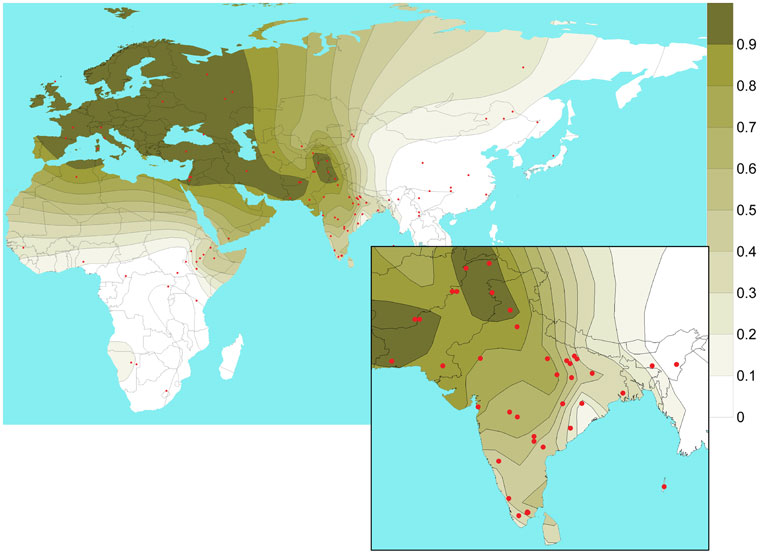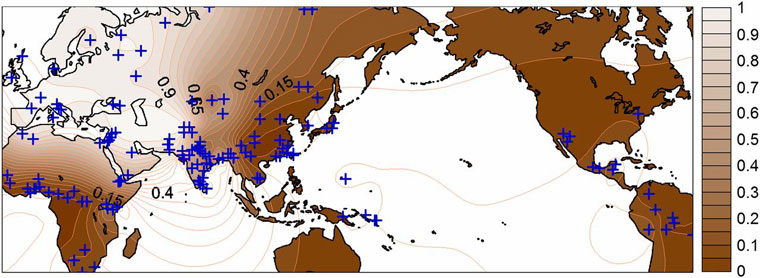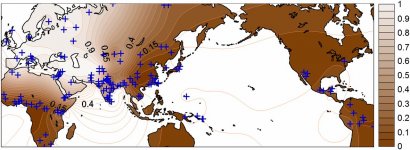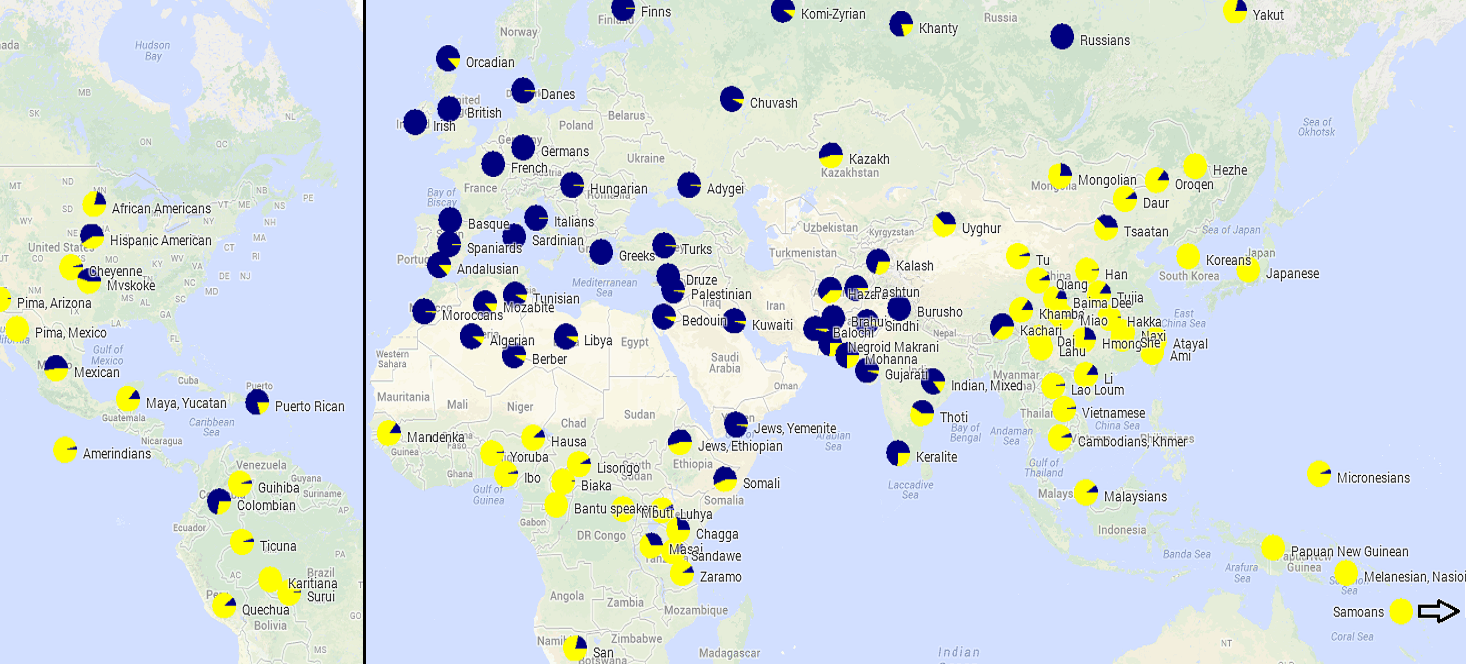A new paper published by V. Canfield and his colleagues looked into the allele distribution of the SLC24A5 gene, whose A111T (rs1426654) mutation is linked with light skin pigmentation in European, Middle Eastern and Central/South Asian populations. The paper comes just two months after a similar study by Mallick et al., which already suggested an Indo-European diffusion of the A111T allele.
A quick glance at the distribution maps of the A111T allele from both studies immediately shows the very strong association with the spread Indo-European languages and paternal lineages (R1a and R1b). The map by Canfield et al. (in brown) displays a particularly strong correlation with Y-haplogroup R1b, showing peaks in the A111T frequencies in Northwest and Central Europe, the Danube basin, the Caucasus, Anatolia, Iran and Turkmenistan.


Where did the light skin allele first appear ?
Mallick et al. estimated the coalescence time of the rs1426654 mutation at 28,100 years, although with a very wide confidence interval (95% CI - 4,900 to 58,400 years), which doesn't help at all determining its place or population of origin.
Canfield et al. narrow this down to 12.4 years ago, with a 95% confidence interval for the range 7.6−19.2 kya. This would correspond to the terminal Upper Paleolithic to the Middle Neolithic period, in other words exactly the period during which I have estimated R1b people to have settled down around modern Kurdistan, domesticated cattle, then migrated to the Pontic Steppe.
It is not certain that the SLC24A5 mutation conferring fair skin arose within haplogroup R. The Mal'ta boy (Y-DNA R*) didn't have it 24,000 years ago. Considering the very dark skin of R2 populations in Southeast India and Southeast Asia, it surely wasn't present among the original R2* lineages either. Based on its equally strong association with modern R1a and R1b populations, it is far more likely to have arisen among R1 carriers. Nonetheless it could just as well have been picked up in another population and been transmitted to R1a and R1b men through the maternal side.
The question is where and when exactly did this mutation occur ? It could have been in Anatolia, Kurdistan or around the Caucasus, but then how comes it doesn't peak in the Middle East today, and is even more common in places like eastern Spain and northern Pakistan at equal latitude ? It could have first appeared among some European tribes during the Late Palaeolithic. However even Mesolithic European samples from Western and Northern Europe had apparently darker skin than Neolithic farmers. Yet it surely wasn't spread by Neolithic farmers, otherwise the Sardinians would be a hotspot of fair skin in Europe, which isn't the case. Greece and western Anatolia also have lower frequencies.
What seems undeniable is that there is a connection to R1a and R1b. My guess is that the A111T mutation arose shortly before the end of the last glaciation (perhaps 18 to 12 kya) among mtDNA U5 lineages of R1 people in Eastern Europe (southern Russia ?).
UPDATE
It's also interesting that the Sahel region of sub-Saharan Africa, where R1b-V88 is found at relatively high frequency in numerous ethnic groups (Fulani, Kirdi, Hausa), falls in the range 15 to 30% for the A111T mutation. This clearly confirms that R1b people already had this mutation before the split between V88 and P297 (M269+M73), which I estimate to have taken place just after the domestication of cattle in northern Mesopotamia 10,500 years ago. The A111T allele frequency also happens to match pretty well the percentage of Eurasian autosomal DNA found in northern Africa (much better than the frequency of R1b, which is more liable to drift).
The very high frequency of A111T alleles along the Mediterranean coast of Africa confirms that the mutation was spread by a variety of historical people from the Middle East (Phoenicians, Arabs) who contributed to the gene pool in the region.
In both maps the gradient over the Sahara is unreliable though, as there are no sampled population between northern Algeria and the southern Sahel (Canfield) or even farther south in Central Africa (Mallick).
A quick glance at the distribution maps of the A111T allele from both studies immediately shows the very strong association with the spread Indo-European languages and paternal lineages (R1a and R1b). The map by Canfield et al. (in brown) displays a particularly strong correlation with Y-haplogroup R1b, showing peaks in the A111T frequencies in Northwest and Central Europe, the Danube basin, the Caucasus, Anatolia, Iran and Turkmenistan.


Where did the light skin allele first appear ?
Mallick et al. estimated the coalescence time of the rs1426654 mutation at 28,100 years, although with a very wide confidence interval (95% CI - 4,900 to 58,400 years), which doesn't help at all determining its place or population of origin.
Canfield et al. narrow this down to 12.4 years ago, with a 95% confidence interval for the range 7.6−19.2 kya. This would correspond to the terminal Upper Paleolithic to the Middle Neolithic period, in other words exactly the period during which I have estimated R1b people to have settled down around modern Kurdistan, domesticated cattle, then migrated to the Pontic Steppe.
It is not certain that the SLC24A5 mutation conferring fair skin arose within haplogroup R. The Mal'ta boy (Y-DNA R*) didn't have it 24,000 years ago. Considering the very dark skin of R2 populations in Southeast India and Southeast Asia, it surely wasn't present among the original R2* lineages either. Based on its equally strong association with modern R1a and R1b populations, it is far more likely to have arisen among R1 carriers. Nonetheless it could just as well have been picked up in another population and been transmitted to R1a and R1b men through the maternal side.
The question is where and when exactly did this mutation occur ? It could have been in Anatolia, Kurdistan or around the Caucasus, but then how comes it doesn't peak in the Middle East today, and is even more common in places like eastern Spain and northern Pakistan at equal latitude ? It could have first appeared among some European tribes during the Late Palaeolithic. However even Mesolithic European samples from Western and Northern Europe had apparently darker skin than Neolithic farmers. Yet it surely wasn't spread by Neolithic farmers, otherwise the Sardinians would be a hotspot of fair skin in Europe, which isn't the case. Greece and western Anatolia also have lower frequencies.
What seems undeniable is that there is a connection to R1a and R1b. My guess is that the A111T mutation arose shortly before the end of the last glaciation (perhaps 18 to 12 kya) among mtDNA U5 lineages of R1 people in Eastern Europe (southern Russia ?).
UPDATE
It's also interesting that the Sahel region of sub-Saharan Africa, where R1b-V88 is found at relatively high frequency in numerous ethnic groups (Fulani, Kirdi, Hausa), falls in the range 15 to 30% for the A111T mutation. This clearly confirms that R1b people already had this mutation before the split between V88 and P297 (M269+M73), which I estimate to have taken place just after the domestication of cattle in northern Mesopotamia 10,500 years ago. The A111T allele frequency also happens to match pretty well the percentage of Eurasian autosomal DNA found in northern Africa (much better than the frequency of R1b, which is more liable to drift).
The very high frequency of A111T alleles along the Mediterranean coast of Africa confirms that the mutation was spread by a variety of historical people from the Middle East (Phoenicians, Arabs) who contributed to the gene pool in the region.
In both maps the gradient over the Sahara is unreliable though, as there are no sampled population between northern Algeria and the southern Sahel (Canfield) or even farther south in Central Africa (Mallick).
Attachments
Last edited:



